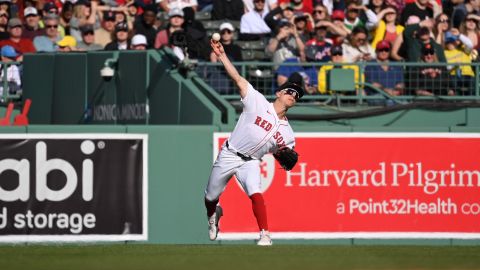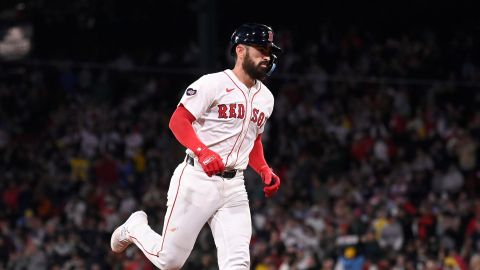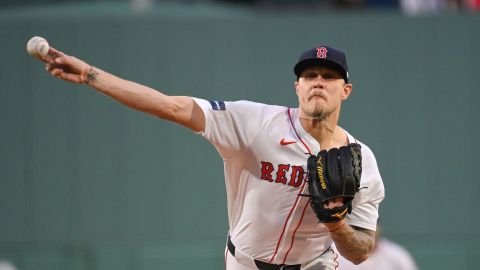Tom Brady would probably kill to play linebacker for a few reps and tackle another team's receivers. Tim Thomas would likely enjoy getting to take a few penalty shots instead of just wearing them off the chest.
But when given the chance to swing for the fences in one of the few interleague games the Red Sox will play in a National League park this year, Josh Beckett was caught looking.
"Caught" may actually be giving too much credit. Beckett wasn't trying to hide a thing, and he did take two swings (one a check swing) in the seven pitches he spent at the plate on Monday night. He struck out twice.
It was a curious approach for a pitcher who needed a few runs, as the Sox eventually fell 4-1. It was also strange because Beckett has hit bombs before — and this was (sort of) his old stomping grounds, at least in that he was playing his former club, the Marlins.
When asked about his hitting approach on the rare times he is called to bat, Beckett has said he just tries swing in the same place each time. The fear of injury is always there for a pitcher, and no one wants someone trying to be a hero when they need to come back out and pitch the seventh.
But, with questions about Beckett's strategy on Monday night aside, his seven lonely pitches at the plate do raise another baseball question: What do we do with these moments that make you cringe for calling ballplayers "athletes"?
When Jane Leavy's book on Mickey Mantle came out, one of the biggest themes many readers took from the research was Mantle's incredible degeneration over his career. That's not an allusion to his cavorting and drinking — the man was literally falling apart from pretty much his first season. He veered away from Joe DiMaggio on a fly ball when DiMaggio was late in calling it, and Mantle tripped in the outfield (some say over a sprinkler head) and ruined his knee for the rest of his life.
As Leavy's book chronicles, Mantle never played on healthy legs. His trainers went through Houdini-like stretches on his knees to pop things back in place and get muscles stretched before games, and Mantle had no cartilage between the key parts. He may have ruined his ACL and MCL pretty early, too — which nowadays means instant surgery, or at least extreme care.
After reading the gory details about Mantle's legs — and looking in astonishment at the stats he put up over a major league career, despite never playing healthy — I mentioned it to my brother. I expected him to say something about Mickey being a champ. His response? "Well, that just shows you that baseball players don't really have to be athletes." If Mantle was in the NBA or NFL, he suggested, his career would have been over. Baseball doesn't require the same contribution from the body.
I don't agree with my brother's point about Mantle, because Mantle was still a superb athlete. He was fast out of the box, slid hard, made diving catches and hit in a variety of ways.
But I can buy the "baseball players aren't really athletes" complaint when it comes to other positions, such as pitchers or designated hitters. Monday night was a first-rate reminder.
Yes, these men can throw nearly 100 mph, or they can swing their sticks hard enough to send a ball into the stands. But do they have the stamina of a marathon runner, the strength of a lineman or the hops of a basketball player? The five-tool player in baseball is lauded because he can use more than one body part at once, but much of the sport is filled with one-skill wonders.
Certain ability goes into playing baseball, and other sports can be just as one-dimensional. A runner is still an athlete, for example. But baseball is also the only sport where people good at only one thing can make millions of dollars without developing another part of their body.
What is frustrating about baseball players is not as much that they aren't required to use many physical skills at once. That's part of the beauty of the game — some hit, some run, some catch, some throw. But the way the sport has developed over the years, it's no longer a question of when the players use those different physical skills, but of whether they use them at all.
A designated hitter should still be able to catch a throw at first (kudos, David Ortiz). An All-Star, Gold Glove first baseman shouldn't inspire fear if he helps out in right field (well done, Adrian Gonzalez). A pitcher should be able to take hacks at the plate once in a while (warning noise).
Baseball is beautiful for how it slices the sporting experience into extremely defined acts, where one at-bat or one throw can be epic. But just because baseball players are so good at channeling all of their athleticism and talent into these moments of beauty and strength doesn't mean that the sport should be allowed to push players to the extremes and not let them develop as athletes.
The one-pitch reliever, the batters who only go against lefties, the permanent designated hitter, the veterans entrenched in one spot on the field — and teams spending exorbitant amounts of money to fulfill these new algorithms of how to squeeze the most out of each optimal matchup — is it worth it? Is shoehorning players into singular roles wrecking the game?
Beckett is an athlete, and he's shown he can do more than throw. Plenty of other guys, when put into different positions, have dusted off secondary skills and made contributions to their teams. But the way baseball is set up now, the sport discourages creativity and stepping outside of the comfort zone for the good of the team.
If a player as good as Mantle can be bashed for his athleticism, what has baseball done in filling its ranks with a bunch of one-trick ponies?



